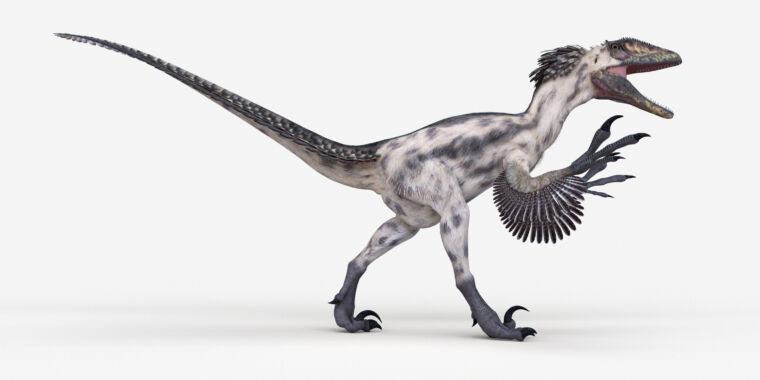Dinosaurs were once thought to be ectothermic, or cold-blooded, which makes sense given that they were reptiles. While scientists have previously discovered evidence of dinosaur species that were warm-blooded, though what may have triggered this adaptation remains unknown. A team of researchers now think that dinosaurs, who already had some tolerance for cold, evolved endothermy, or warm-bloodedness, to adapt when they migrated to areas with colder temperatures. They also think they have found a possible reason for the trek.
Using the Mesozoic fossil record, evolutionary trees, climate models and geography, plus accounting for a drastic climate change event that caused global warming, the team found that theropods (predators and avian ancestors such as the velociraptor and T. rex) and ornithischians (such as Triceratops and stegosaurus) must have moved into colder regions during the Early Jurassic. Lower temperatures are thought to have selected for species that were partially adapted to endothermy.
“The initial invasion of cold niches… [suggests] early attainment of homeothermic (perhaps endothermic) physiology v [certain species]allowing them to colonize and persist even at extreme latitudes since the Early Jurassic,” the researchers said in a study recently published in Current Biology.
Hot real estate
During the Mesozoic Era, which lasted from 230 to 66 million years ago, proto-dinosaurs known as dinosauromorphs began to diversify in a hot, dry climate. Early sauropods, ornithians, and theropods tended to stay in these areas.
Sauropods (like brontosaurus and diplodocus) would have become the only dinosaur group to bask in the heat—the fossil record shows that sauropods tended to stay in warmer areas, even when there was less food. This suggests a need for sunlight and heat associated with ectothermy. According to one hypothesis, they may have been able to survive in colder temperatures, but were not adapted enough to do so for long.
It’s also possible that living in cooler areas meant too much competition with other types of dinosaurs, as theropods and ornithists eventually moved into those cooler areas.
Almost an apocalypse
In addition to ecological opportunities that may have attracted dinosaurs to cooler regions, it is possible that they were driven out of warm ones. Around 183 million years ago, there was a disruption of the carbon cycle along with extreme volcanism that released huge amounts of methane, sulfur dioxide and mercury. Life on Earth suffered from searing heat, acid rain and forest fires. Known as the Early Jurassic Jenkyns Event, scientists now believe that these disruptions pushed theropod and ornithischian dinosaurs into colder climates as temperatures in warmer zones exceeded the optimal temperatures for their survival.
Theropods and ornithischians that escaped the effects of the Jenkyns event may have had a key adaptation to colder climates; many dinosaurs from these groups are now considered to be feathered. Feathers can be used to both trap and release heat, which would have allowed feathered dinosaurs to regulate body temperature in a wider variety of climates. Modern birds use their feathers in the same way.
Dinosaur species with feathers or special structures that improved heat management may have been homeothermic, meaning they would have been able to maintain their body temperature by metabolic activity, or even endothermic.
In addition to dinosaurs migrating to high latitudes and adapting to the drop in temperature, endothermy may have led to the rise of new species and lineages of dinosaurs. It may have contributed to the rise of Avialae, a clade that includes birds—the only true dinosaurs still around—and traces back to their earliest ancestors.
“[Our findings] provide new insights into the origins of avian endothermy, suggesting that this evolutionary trajectory in theropods … likely began in the latest Early Jurassic,” the researchers said in the same study.
That’s really something to think about when a sparrow flies by.
Current Biology, 2024. DOI: 10.1016/j.cub.2024.04.051
